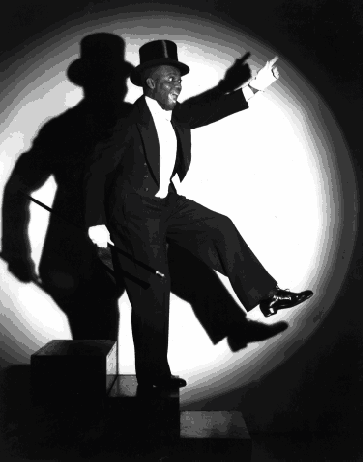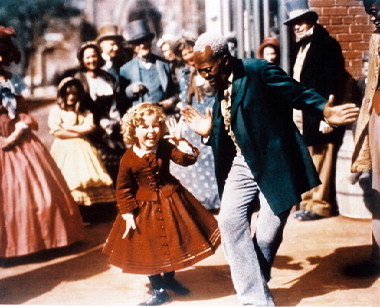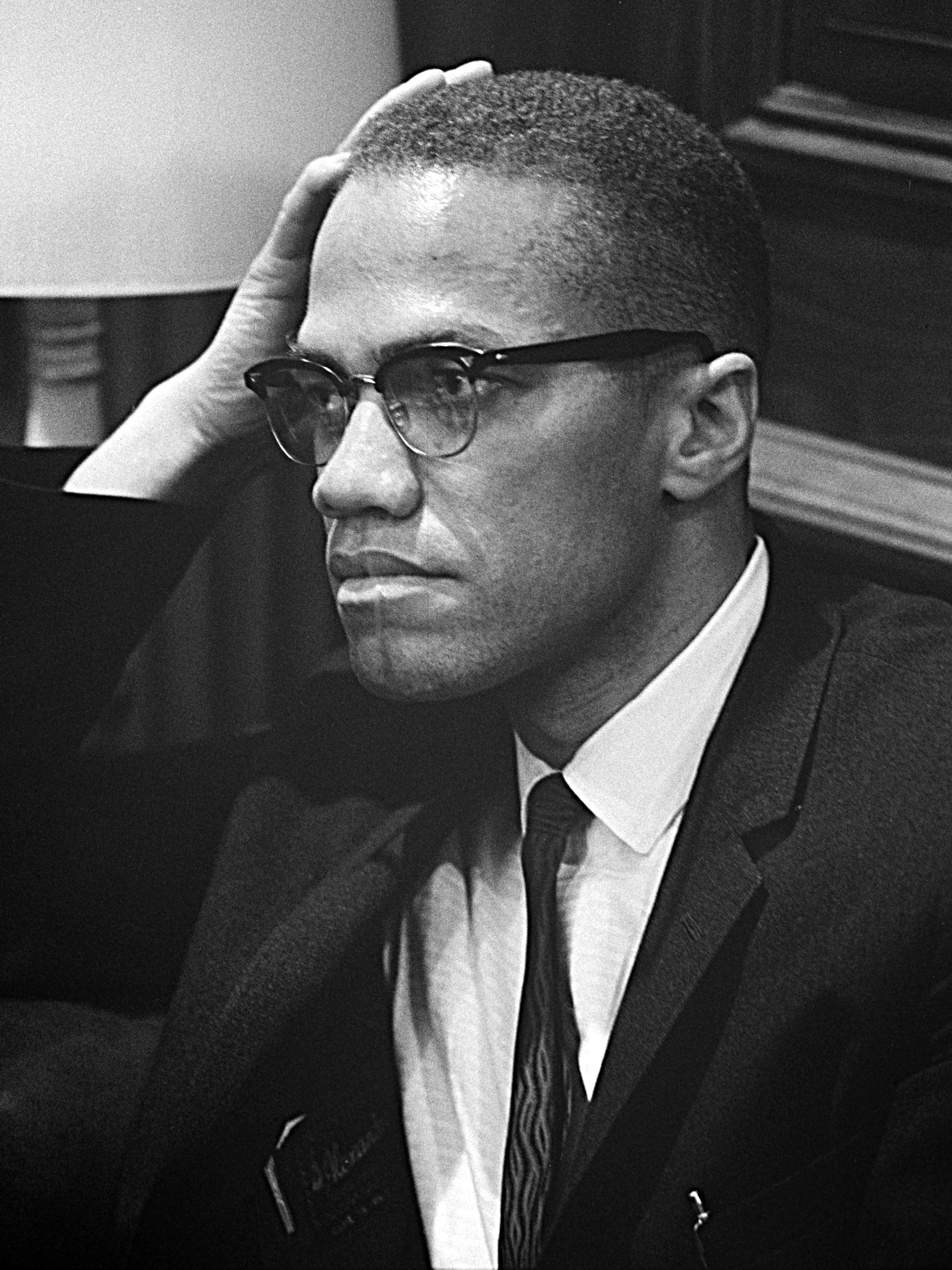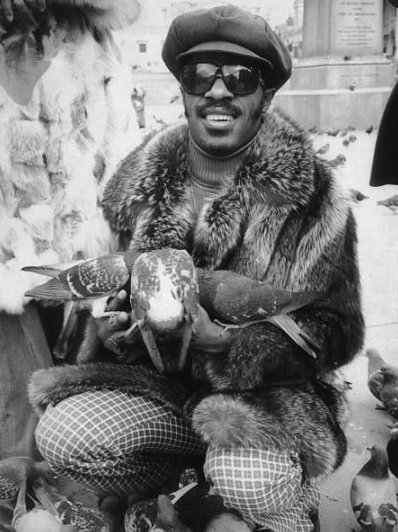Wednesday, 27 January 2010
Barima in Print
I'm in the current issue of The Chap and had forgotten about it. The link is in the sidebar. It transpires that my full name is too long for publication
Tuesday, 26 January 2010
If I Were in London...
... I'd be wearing something like this oldie photo, here:
Actually, I'll return on Thursday morning, so this is utterly relevant. I hear it's a little nippy out and that I have to stay away from the yellow snow. Luckily, I have some pigskin gloves that I'll be taking out for a little spin
Actually, I'll return on Thursday morning, so this is utterly relevant. I hear it's a little nippy out and that I have to stay away from the yellow snow. Luckily, I have some pigskin gloves that I'll be taking out for a little spin
Monday, 25 January 2010
The Bojangles Post
The Bill 'Bojangles' Robinson Monument in Richmond, VA
Bill ‘Bojangles’ Robinson (1878 - 1949) is the perfect representative of a favoured archetype of mine; the energetic, sharply dressed, dynamic hoofer of the early 20th century. Alongside Gene Kelly, The Nicholas Brothers and, of course, Fred Astaire, he is also an ideal exemplar for the freedom, precise lines and pure élan of skilled tailoring. His capacity for generosity, dignity and rising up against all the odds that faced him are also excellent guidelines for living
As a man of motion, his jackets gave him the freedom to perform his steps whilst looking his best. Look at how the low padded shoulders and the height of the armholes combine to allow him near-unrestricted movement without distorting the garment’s structure. The sweeping belly of his lapels and loosely structured fit add to his energy and agility immensely
For those who appreciate my use of full cut trousers, this is where it comes from. What gives Bojangles the edge is that he has no need for my kaleidoscopic enthusiasm; his flamboyance lies in the cut, which is simply of its time
There is any number of reasons as to why his style has not passed on into public legend, but he is as admirable to me as Cary Grant is to everyone else. Ever complimentary of other footwork talents, Astaire’s tribute to him in 1936's Swing Time may be history’s only relatively passable example of blackface, and I say that because I've no real reason to doubt Astaire's sincerity:
Unexpectedly, his baton was taken up briefly in 2003 and 2004, by, of all people, will.i.am in the ‘Hey Mama’ video and Usher in ‘Caught Up’, respectively. The choice of garments and silhouettes, along with the fact that both men use the videos to highlight their skill as dancers is indicative of inspiration, if not tribute
Dancing alongside Shirley Temple
I wouldn’t go as far as to include myself as part of his legacy, although an uncle of mine teasingly referred to me as ‘Bojangles’ after I danced with everyone in sight at a recent wedding reception. I still can’t say that I’m not flattered
Saturday, 23 January 2010
In Their Element
The In Group – 18th July 1967
Back Row: Susannah York, Peter S. Cook, Tom Courtenay, Twiggy
Centre: Joe Orton, Michael Fish
Front Row: Miranda Chiu, Lucy Fleming
I’ve felt like sharing this Patrick Lichfield-shot image for a while; it’s been a favourite since a collection of Swinging London photographs passed through my field of browsing vision some time in the distant past. I certainly think this mixture of languor, exclusivity and energy ranks with his airily bohemian portrait of Yves Saint Laurent in Marrakesh two years later, even allowing for their compositional differences
It also seems to be the only reference for what the man who devised the kipper tie and the wardrobes of Terence Stamp in Modesty Blaise, Jon Pertwee in Doctor Who and Peter Sellers in There’s a Girl in My Soup, Michael Fish, looked like, never mind anything more recent. Surrounded by other luminaries of his scene and taking centre stage in clothing of his own design, one can discern the flair and the garrulousness that made him and his work a desirable commodity; the latter still is, if I have anything to say about it
It also seems to be the only reference for what the man who devised the kipper tie and the wardrobes of Terence Stamp in Modesty Blaise, Jon Pertwee in Doctor Who and Peter Sellers in There’s a Girl in My Soup, Michael Fish, looked like, never mind anything more recent. Surrounded by other luminaries of his scene and taking centre stage in clothing of his own design, one can discern the flair and the garrulousness that made him and his work a desirable commodity; the latter still is, if I have anything to say about it
The online provenance of this image lies with Shana Ting Lipton; her mother, Miranda Chiu, is seated by Fish’s right knee. Ms. Lipton, an international pop culture and travel writer/editor/journalist and cultural researcher/strategist with an incisive worldview and an exceedingly interesting website, is ostensibly who I want to be when I grow up. My world could certainly use more of her like
In terms of appearances, there’s certainly a marked difference between this clan of memorable tastemakers and the brand name/High Street scruff of today’s Hot Young Things in an identikit photoshoot. It’s all in the elements
Tuesday, 19 January 2010
Monday, 18 January 2010
Relaxed Suiting
The Fifth Earl of Lichfield, Thomas Patrick John Anson, via LIFE Magazine
Men who want to leave the suit behind when their day is done at the coalface are shortchanging themselves. Learning to adapt and procure suits for occasions and for pleasure is merely another aspect of the fun that comes with sharpening one's image. And that suits-with-trainers lark only ever worked for downtown New York New Wavers and David Tennant
There are other options, you know:
There are other options, you know:
YSL, circa 1969
Also from LIFE, The Beatles take Japan. And Lennon probably didn't need to ask anyone if it was acceptable to sport a muted pink suit
Etro, via the NY Times; the label has entirely defined itself through uncompromising flamboyance, sharp cuts and playful patterning
Etro for summer. There's only one element I'd not wear
The post-colonial African hipster look revived for the NY Times. Suits by Viktor & Rolf (l) and Dries Van Noten (r)
Let's face it; the mods, suedeheads and peacocks were deriving much enjoyment from their appropriation of traditional dress codes and the results thereof. It's all over Patrick Lichfield's face up above; he's bold, but not over the top, able to enjoy his appearance without being self conscious about it. Given what parades up and down today's metro paving, it's only out of the ordinary because sartorialism is the current incarnation of iconoclasm. Having said that, it still takes a brave or uncaring man to wear a hat crown as large as his face
Mick Jagger and Mary Whitehouse. Really
The 1971 wedding of Mick and Bianca Jagger. His suit was from Nutter's of Savile Row; at this time, the pattern was cut by master tailor Edward Sexton. His shirt was created by Deborah & Clare of Beauchamp Place. The photograph is, of course, by Patrick Lichfield, via The Independent
It's been well documented that I achieve a more informal look the same way other likeminds do; my shirt and tie combinations could only really be seen at parties or in a creative office. Anyone who really thinks bold ensembles are de rigueur in a conservative professional environment is an idiot or has befriended one too many wide boys. But going the other way and playing the colour field down doesn't harm a suit's out-of-the-office cachet:
Knit tie, green pocket square, striped cardigan; relaxed in more of a cosy sense than a creative one, but also perfectly felicitous for a dressy occasion
Rather than simply thinking "It's not for me" or "I'm not (delete as appropriate) cool/rich/famous/handsome/slender/crazy enough to pull this off," you simply have to remember that menswear is about the details. For every exuberant pattern, there must be a balancing act performed by the cut; it must, of course, fit exceptionally well. Don't compound the potential shock factor of a statement fabric with offbeat tailoring decisions (unless it's a shorts suit, which is a topic for a future time). Stick with two buttons in a single breasted or go double in a 6x4 configuration. Rather than standard padded shoulders, why not try roped shoulders and/or lightly padded natural shoulders. Retain a well shaped silhouette with subtle buttons. Let the fabric do the shouting
If anyone would like a place to start, I can think of nowhere better than Dashing Tweeds. Their Exploded Houndstooth design has previously appeared on this column. I do like this Foulkesian 3-piece tailored from one of their cloths by Savile Row's Davies & Son:
Via James Sherwood
A final thought: don't neglect the outerwear
Labels:
1960s,
article,
colour theory,
Dashing Tweeds,
dries van noten,
etro,
icons,
menswear,
music,
outfit,
Patrick Lichfield,
photo,
Style,
suit,
tailoring,
viktor and rolf,
yves saint laurent
Wednesday, 13 January 2010
Frame Yourself
Via NY Press, Run DMC's Darryl McDaniels sports his Ultra Goliath sunglasses at the height of the band's fame, although he's commonly (mis)perceived as a Cazal man. Originating in the late 1970s or early 1980s, the Goliath is also favoured by famed horror filmmaker and Grandfather of the Zombie, George A. Romero and worn by Elliot Gould in the Ocean's 11 trilogy and Robert De Niro in Casino, as well as by the late flamboyant actor and game show host Charles Nelson Reilly. My online colleague Matthew of Tweed In The City owns a pair made by Cutler and Gross
I feel sorry for those who don't know what they're missing in the eyeframe world. The folks sporting over-or-undersized, heavily logo'd plastic jobs of questionable quality certainly don't merit my envy
In today's world, for design, craftsmanship or both, I can think of around five names to count on; Oliver Peoples, Ben Sherman, Tom Ford, Alain Mikli and, of course, Cutler and Gross of London. Again, note that I'm not claiming each brand combines both design and craftsmanship, although most certainly do. If you think you've spotted an odd one out, you're correct; I just rather like the aesthetic that this mod institution continues to push, plus I'm sure we all know by now that I'm not consistently fussy about where I shop. I also admit a certain fondness for makers I'm not very familiar with such as Kata and Rochas
Via Hub Pages; well it would be remiss of me to leave her out, wouldn't it?
Ben Sherman, via Uncrate. They bring to mind a larger pair worn by Jim Hacker in Yes, Minister, although his were reading glasses
Serengeti sunglasses via Sunglasses Shop. The maker generally uses glass photochromatic lenses, making them highly valuable
I've always liked the idea of signature sunglasses and yet I feel that such "One Sunglasses Only" people of style are limiting themselves a touch. Of course, those I am thinking of, such as Malcolm X, happen to be dead. Stevie Wonder is such a man with different styles, all pretty much iconic by virtue of his face and look(s), but tragically (crass as this may sound), he has never known how cool he appears
From Wikimedia, Malcolm X and his Ray Bans Clubmaster frames
Marianne Faithfull
The late Richard Merkin
Typically, I like to go vintage; though not typically an aviators fan, I've owned two pairs in the past: one 1980s pair by Ferrari and a more recent pair from Ray-Ban. Speaking of which, bypass the current Ray-Ban range and seek out their classic older offerings, made with far more attention to detail and sturdiness by founder company Bausch & Lomb. Like its fellow iconic eyewear brand, Persol, Ray-Ban is currently owned by the Luxottica company and really was better made around 30 years ago
I'm also quite fond of oversized eyeframes; the nostalgic images evoked in my mind are of Jewish businessmen, British politicians, Mob members and old school rappers. Designer Antonio Azzuolo personally favours old Christian Dior frames and each of his presentations have featured his models in large deadstock sunglasses. To add some perspective, here's an informative archive post from the Beastie Boys' message board, mainly focusing on the infamous Cazal lines:
"Carl Zolinni starting making Cazal glasses in 1975. Hence the name "CAZAL." I have one of the first Cazal's ever from 1975. They sucked! Cazal started to get good around 1978. Then the "Cazzie Craze" hit in '82. People were dying for these glases much the way people were getting killed in Harlem for their Jordan 1's and 2's in the mid 80's. Optometrists in NYC kept them in the vault and it was real hush hush if you had them. Then the optometrists made so much in NYC in the 80's on these things they all retired in Florida in the late 80's, where many of these glasses can still be found to date
"A big misconception was people calling them "Cazzelle". People pronounced them like the Adidas shoe "Gazzelle." Not true. I met with the president of Cazal once and he said they are "CAZAL." Some people think Cazal started the big glasses craze of the late 70's but it was really Neostyle that hit it off with their "Nautic" line. Also, Ultra's Claudia Carlotti and Versace lines helped kick off their stardom. Ultra Palm is the US distributor for Cazal and made Versace big in the late '70s. Persols were more late '60s with their wraparound line, so I won't mention them much
"Peace out,
-JK"
Latterly, Cazal has (of course) accredited cachet amongst today's day-glo scenesters, who are neither mugged nor killed for theirs unlike the aforementioned actual trendsetters. Whilst iconic for a certain era, they aren't generally for me. I am, on the other hand, a fan of the abovementioned Neostyle, as well as Alpina, Vuarnet, Playboy and Dunhill in its Optyl-manufactured era (the link necessarily directs to the history of another likeable maker, Carrera)
The wild exuberance, brash sizing and ornate stylings of these frames was a consequence of sunglasses moving towards statement status in the 1960s; my overall favourites - Ultra's own name range, including the abovementioned Goliath and other appropriately-yet-whimsically named frames, such as "Sudan," "Zeus" and "Rangoon" - tended to let their size and shape do the speaking. Ironically, the frames that currently best fit my face are a pair of modern Dunhills, but sometimes, comfort wins out. Still, one has to love the classics:
The wild exuberance, brash sizing and ornate stylings of these frames was a consequence of sunglasses moving towards statement status in the 1960s; my overall favourites - Ultra's own name range, including the abovementioned Goliath and other appropriately-yet-whimsically named frames, such as "Sudan," "Zeus" and "Rangoon" - tended to let their size and shape do the speaking. Ironically, the frames that currently best fit my face are a pair of modern Dunhills, but sometimes, comfort wins out. Still, one has to love the classics:
Vuarnet
Want a New Year's Resolution? Frame yourself
Labels:
accessories,
article,
fashion,
menswear,
music,
pop,
Style,
womenswear
Wednesday, 6 January 2010
Cally Blackman - 100 Years of Menswear
Cally Blackman’s 100 Years of Menswear was curated with a more general, and pictorial, approach than was taken in other 2009 works such as Nicholas Storey’s History of Men's Fashion and Eric Musgrave’s Sharp Suits. However, it is no lesser for it and its juxtapositions of traditional style with the shifts and challenges of fashion are certainly worth more than the occasional glance. The languid posture of the younger, rockabilly-haired David Bowie on the cover, clad in a pale mustard shawl collared suit and a yellow/white horizontal striped towelling shirt – ever straddling boundaries – typifies this approach rather well
It is light on words – though the paragraphs contain the necessary amount of elucidation – and heavy on imagery, which is, of course, the true draw. Unearthing a rich seam of photography from the early days of the 20th century onwards is an accomplishment I hope Blackman is proud of, and her consummate approach is testament to her knowledge and passion. Although she is careful to touch on the major – and by now obvious – style leaders and designers we all know (Astaire, Grant, Eden, Wolfe, Windsor, Saint Laurent, Gatsby/Redford, Jagger, Nutter, Ford, Lauren, Armani), a welcome inclusion of cultural context often pervades. I did wish at times that she would concentrate on some less trodden paths such as the aesthetes of Paris (although her curation of artistic styles in Europe between 1900 - 1939 is characteristically spot-on, at the very least, I feel that I know too little about the French creativity, dandyism and bohemianism of the period) the Suedeheads of the 1970s and the less clichéd side of Edwardian England, but there were, for me, genuine moments of enlightenment such as the Zazous of the 1940s, a nonchalant European counterpart to the Zoot Suiters
The overall effect Blackman seems to aim for is one of clothing through culture and time of place rather than technicality, although the evolution of design and technique is obviously not ignored. Nevertheless, given that her foreword asserts that menswear is in fact as diverse and interesting and more influential than womenswear, the sheer variety of pictures almost flawlessly supports her on each point
In this respect, and that of the changing fashions depicted within, the book champions a concept I'm rather attached to - menswear has far more to offer than we may think today. As the selection of modern day images of celebrities and fashion shoots somewhat ironically displays, we stopped trying, to our disadvantage, no less. It's cultural degeneration portrayed through morphing and dying sartorial codes; the old adage about pictures and words is more than apt, for once
The book is divided into sections by period of time and also by title. Naturally, my favourite section is "Peacock", which starts with the tweaks and experimentations of late 50s Continental tailoring and early 60s Pierre Cardin before flowering into the daring (and drugs) of the Peacock Revolution, the Counter Culture and the continued rise and rise of pop music. Second to this - despite its brevity - the use in "Suit" of a Laurence Fellows-drawn Esquire advert with the advice still intact (and an Anthony Eden-inspired one, no less) made me smile appreciatively. I don't yet have a third, but that will come in time - a strong contender is "Culture Clubber", since 1980s street fashion is rather close to my heart. 1980s hip hoppers and their oversized eyewear are more woven into my dress style than some might think
Though this is not truly a history book - in this respect, we have enough of those - I was reminded why I, in my youth, thought I wanted to be a historian after my first read-through. It was not to lecture about Vietnam or The Battle of Agincourt; it was about learning about what changed and why. Pop culture dissection that so ably combines two of my interests is certainly worth purchasing, and so 100 Years of Menswear may become one of my favourite Christmas presents ever
Even if it was from myself
The overall effect Blackman seems to aim for is one of clothing through culture and time of place rather than technicality, although the evolution of design and technique is obviously not ignored. Nevertheless, given that her foreword asserts that menswear is in fact as diverse and interesting and more influential than womenswear, the sheer variety of pictures almost flawlessly supports her on each point
In this respect, and that of the changing fashions depicted within, the book champions a concept I'm rather attached to - menswear has far more to offer than we may think today. As the selection of modern day images of celebrities and fashion shoots somewhat ironically displays, we stopped trying, to our disadvantage, no less. It's cultural degeneration portrayed through morphing and dying sartorial codes; the old adage about pictures and words is more than apt, for once
The book is divided into sections by period of time and also by title. Naturally, my favourite section is "Peacock", which starts with the tweaks and experimentations of late 50s Continental tailoring and early 60s Pierre Cardin before flowering into the daring (and drugs) of the Peacock Revolution, the Counter Culture and the continued rise and rise of pop music. Second to this - despite its brevity - the use in "Suit" of a Laurence Fellows-drawn Esquire advert with the advice still intact (and an Anthony Eden-inspired one, no less) made me smile appreciatively. I don't yet have a third, but that will come in time - a strong contender is "Culture Clubber", since 1980s street fashion is rather close to my heart. 1980s hip hoppers and their oversized eyewear are more woven into my dress style than some might think
Though this is not truly a history book - in this respect, we have enough of those - I was reminded why I, in my youth, thought I wanted to be a historian after my first read-through. It was not to lecture about Vietnam or The Battle of Agincourt; it was about learning about what changed and why. Pop culture dissection that so ably combines two of my interests is certainly worth purchasing, and so 100 Years of Menswear may become one of my favourite Christmas presents ever
Even if it was from myself
An Autre Evening
Photograph by Amina Nolan. Aside from her obvious talent, the lady must be credited for somehow recrafting the drab London of 2009 as the vibrant, hedonistic Paris of 1969, or something like that. It is actually scanned from a traditional film photo. Perhaps I should be holding a cigarette
Ah, October. 3am on a Soho morning, following a missed talk at the Arts Club, several uninvited peeks through open doorways and an hour's dancing in a cafe that refused to close
We met these two at Ronnie Scott's, as one does, I suppose. I am still yet to send them this address
We met these two at Ronnie Scott's, as one does, I suppose. I am still yet to send them this address
Sometimes, I really love the nightlife
Monday, 4 January 2010
Cornelius - '2010' (1997)
This bears a warning - it should not be listened to, under circumstances, by those of a nervous, or staunchly classicist, disposition. For it is perhaps the most gleefully childish and senses free cover of Johann Bach's piece that exists. And I say that despite being no authority on Bach covers whatsoever
Every Cornelius album since 1995 has borne a cover of a reasonably well known song; this rather makes that year's somewhat disquieting fusion of Vivaldi's 'Concerto No. 3 From The Four Seasons' and Black Sabbath's opening riff to 'Iron Man' (complete with bizarre neo-psychedelic electronics and the title 'Pink Bloody Sabbath') seem like relaxation music by comparison. But then how else should a downloaded MIDI over drum'n'bass and wild samples from deep space satellites and the Oscar-winning classic Amadeus make one feel?
As far as I'm concerned, pretty bloody marvellous; at least where the first few days of this year are concerned. Happy New Decade, and do I wish that I'd been able to post this last Friday
Labels:
broken ipod blues,
Cornelius,
Japan,
music,
party,
pop,
Shibuya-kei
Subscribe to:
Comments (Atom)










































